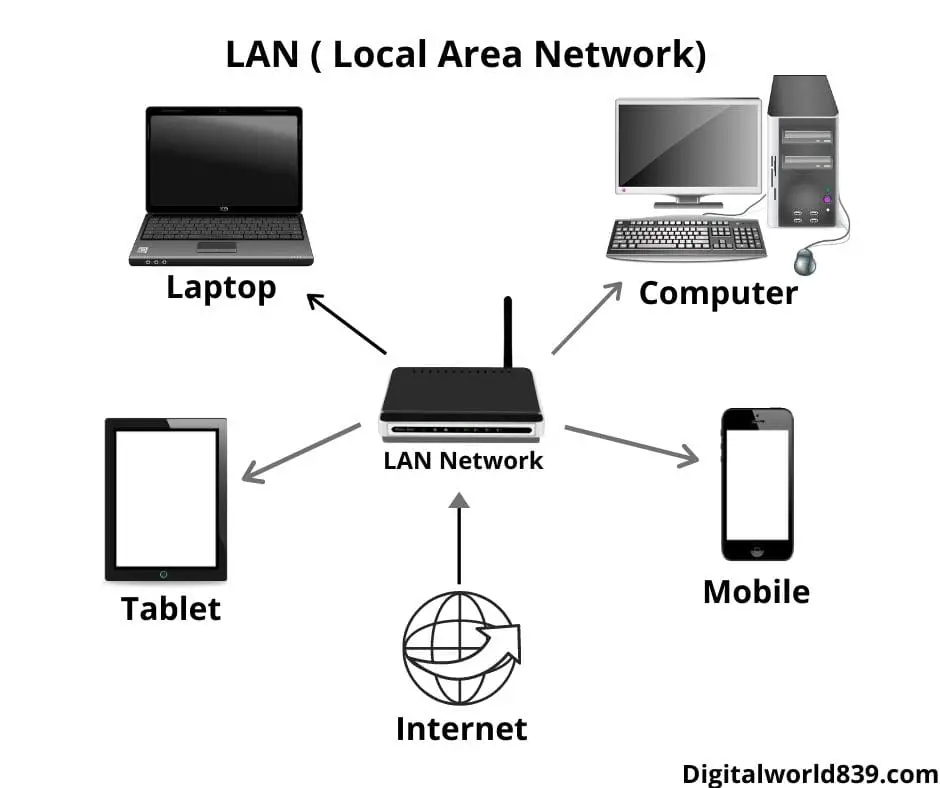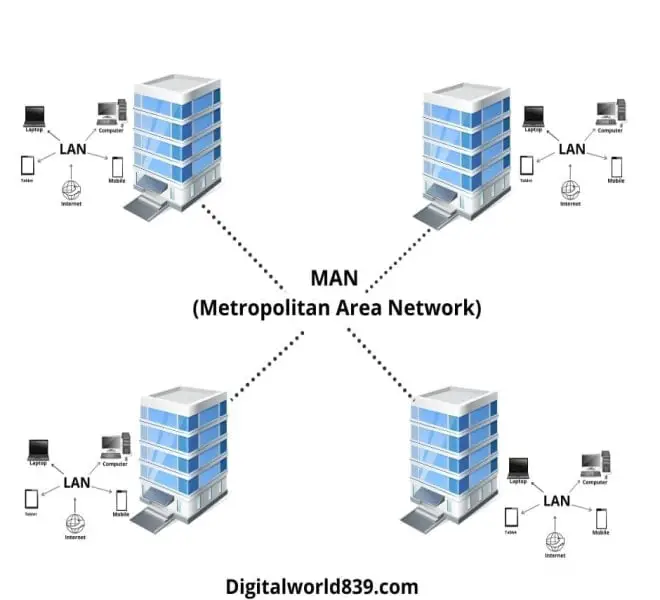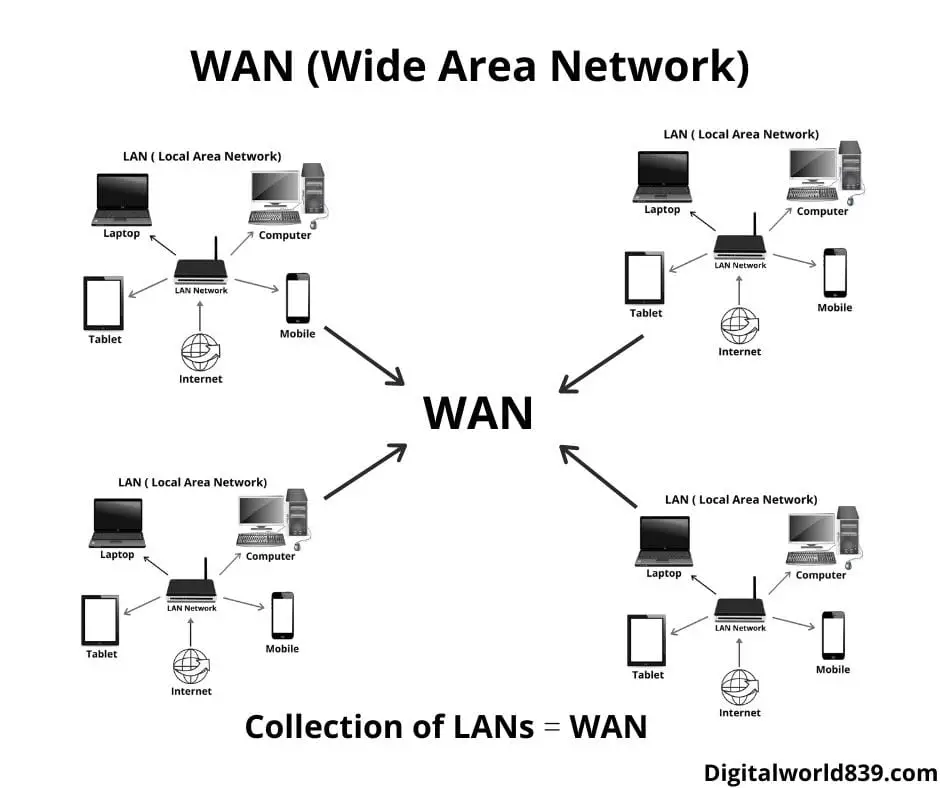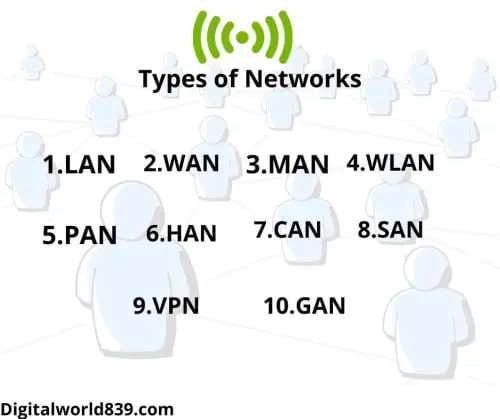In today’s world, we are connected with many types of networks like LAN, WAN, and MAN through the internet.
These are the most popular and major network types that help us to share and access data and information digitally. Let’s know the LAN, WAN, and MAN with diagrams in detail.
Also Features and the differences between LAN, MAN, WAN, with the comparison chart.
LAN vs MAN vs WAN
1. LAN
The full form of LAN is the ‘Local Area Network. ‘ As the name suggests, it connects the computers by covering the local area within 10m to 1.5 km. Since it covers a small local area, you will find LAN in local places like offices, colleges, schools, groups of buildings, business organizations.
This network is managed and used by one person or one small organization. This network is used for resource sharing, data storage, document printing by connecting devices like printers, scanners, projectors, and other storage components.
In (LAN, WAN, and MAN), The LAN is often connected with Ethernet cables and Wi-Fi also Token Ring and Fiber Distributed Data Interface, or FDDI, TCP/IP are the most common protocol that is used in this network.
When you share your internet connection with someone else, such sharing is also an example of LAN. The smallest LAN can be made up of only two computers.
The transmission rate of LAN ranges from 4Mbps, 16Mbps, 100Mbps, and in some cases supports gigabit speed which is 1000Mbps. For the interconnection of the host in LAN, we can use any type of network topology which meets the need of the network such as a bus or ring topology.
In a LAN, we can connect up to 1000 computers. Most LANs are used in wire connections. But nowadays, it is also being used without wire, i.e., in wireless connections.
The bonus point of this network is its high speed, and lower expenses, as well as the security.

Features of LAN:
- The network capacity of a LAN is limited to a single room and small geographical areas like homes, small firms, and offices.
- The LAN has the advantage of high speed for data transfer.
- File transfer and recovery are more manageable in a LAN network because backup files are stored in a server.
- It has no connection with the external system, which ensures privacy.
- The LAN network is a private network, it doesn’t own by any government bodies.
- The network ranges from 1m to 1.5km.
Uses of LAN:
LAN often use as a local network at home for sharing data as well as on-campus of a college and school. Similarly, LAN is used as an intranet for business organizations via wifi.
Advantages of LAN
Disadvantages of LAN
- Setup Cost: Although LANs will save costs over time due to sharing computer resources, the initial cost of establishing a local area network is a bit expensive.
- LAN Maintenance: Local area networks require a LAN administrator for handling software installation, wiring setup, wifi router hardware failures, or cable malfunctions.
- Server Load: If the server is not very good, it cannot overload many computer connections, which can cause damage.
- Network Security: There is a risk of insecurity because hackers can enter the system. Similarly, viruses, malware can also enter into a LAN it can damage all those that are connected.
- Covers Limited Area: The local area network is limited covers only a small area such as a home, an office, a building, or a cluster of nearby buildings.
2. MAN
The Full form of MAN is the ‘Metropolitan Area Network.’ The WAN is a superior version of the LAN network, often used in cities and other locations covering a range of 5-60 km to transfer data at high speed.
MANs are high-speed connection networks because It is an extensive network by connecting several LANs into a single large network with a common bridge.
Under this network of MAN, two or more local area networks are connected. That bridge is called the backbone line which is usually established by optical cable and twisted pair cables to boost data transfer speed.
This network connects all the prominent colleges, schools, and government offices, business organizations in the city. Thus, we can say that a MAN network is made up of multiple LANs.
The best example of a MAN is Cable TV situated in the middle of a city, as its cable spreads throughout the city, and the user uses the service through the cable network.
A big business organization has its own MAN. Through which it connects to a different branch. If such networks start being used on a college campus, they call it a CAN (campus area network).
MAN can be considered as a group of one or more LAN networks connected together through a single cable. RS-232, X-25, Frame Relay, and ATM are the common protocol practice for communication in MAN.

Features of MAN:
- The network coverage of MAN is more massive than LAN but smaller than WAN.
- It is bounded in large geographical areas such as a town, city.
- The data transmission speed is moderate.
- Its ownership can be public or private parties.
- The network ranges from 5 to 60km.
Uses of MAN:
MAN is used in various government bodies, police stations, private firms that are situated within a city. The officers, employees can easily communicate either with each other or between their departments and branches in order to pass the important data and message quickly over this network without any need for an Internet connection.
Thus it provides various resource sharing over a large distance in the city than the LAN networks.
Advantages of MAN
Disadvantages of MAN
3. WAN
A WAN full-form is ‘Wide Area Network. ‘ A WAN is used to connect computers that are not close to one another. It is the collection of many LANs with a much more extensive range than LAN and MAN.
In LAN, WAN, and MAN, the WAN network’s geographical periphery is more widespread such as a network of systems spread across the entire city, country, or even continent.
This network connects has similar structures, as LANs and MANs. Most WANs are public networks, like the phone line and satellites, telephone systems, or leased lines.
Generally, fiber optic cable is used as a medium for transmission in WAN. This network works on physical, data-link, and network layers of the OSI Reference Model.
Devices involved for the transmission of data, images, video, big database, and files in the connection of WAN are more diversified, ranging from routers to switches, bridges, firewall modems, and so on.
Some of the most common WAN protocols in use today are Frame Relay, X-25, Integrated Services Digital Network, or ISDN, and Point-to-Point Protocol, or PPP.
An example of the largest WAN is the Internet. Through the Internet, people can connect from one place or other computers or users anywhere in the world. It is implemented by a public broadcasting system.

Features of WAN:
- It is generally used for voice and data for mobile and landline phone applications.
- A large number of people can communicate with one another in this single network.
- Its data transmission speed fluctuating sometimes slow or even very fast.
- The network range or coverage area of a WAN is more massive, from which we can transfer the data across the world.
Uses of WAN:
The WAN networks are used for military services. There is a satellite method of transmission is used in this setup. WAN is used in this field for the communication and operation of the military with high security.
Airlines and Railways use WAN networks for booking tickets from anywhere in the country. The is done because client nodes are situated all over the country and are connected to a centralized server to one network.
Advantages of WAN
Disadvantages of WAN
Difference Between LAN, MAN, and WAN
LAN vs MAN vs WAN: Comparison Table
Comparison | LAN | MAN | WAN |
1. Full form | Local Area Network | Metropolitan Area Network | Wide Area Network |
2. Speed | Higher bandwidth, Data transfer speed ranges from 4 Mbps to 16 Mbps and can maximize up to 100 Mbps. | Moderate bandwidth, speed of data transfer normally reaches up to 100 Mbps. | Slower bandwidth, normally speed of transfer have 10 Mbps. |
3. Installation and Maintenance | The installation and maintenance process of the LAN is easy. | The installation and maintenance process of the MAN is a little difficult. | The installation process and maintenance of WAN is very difficult. |
4. Coverage | The range of LAN is between 10 and 1500 meters. | The range of MAN is between 5 to 60 km. | The range of the Wide Area Network is up to 100000 km. |
5. Ownership | The LAN is often owned by by a single person or organization. | MAN is owned by both Public and private parties. | WAN can be owned publicly or privately. |
6. Networking Devices | The LAN technology allow computers to communicate with each other as well as the networking devices like Wi-Fi, Ethernet Cables,Token Ring and Fiber Distributed Data Interface, FDDI, TCP/IP, etc. | Modem snd Wire Cables like optical cable and twisted pair cables. | Optical wires, routers, switches, bridges, firewall modems and Satellite. |
7. Uses | It used in places like colleges, offices, or hospitals. | It used in Small towns and in a particular city. | It used by a large number of people across the city, country and even Continent. |
8. Examples | Cable TV network. | Internet. |
Conclusion:
In this article, you have learned the features, uses, advantages, and disadvantages of LAN, MAN, and WAN a basic computer networking system. All three types of network systems have their own significance in different scenarios.
As per the latest trend,
FAQs
How LAN is different from WAN and MAN?
The LAN stands for ‘Local Area Network’ covers the area ranging between 10 and 1500 meters, places like colleges, offices, and hospitals. While WAN stands for ‘Wide Area Network’ covers the area up to 100000 km means across the city, country, and even Continent.
Are WAN and LAN cables the same?
No, LAN often uses ethernet cable while WAN uses fiber optic cables for data transfer.
Are LAN cables and ethernet cables the same?
Yes, the LAN often use an ethernet cable for data transferring between the connected devices, however today wireless connection such as wifi is also being used as Wireless LAN connection (WLAN) both are the same and covers the limited area.
Can LAN be wireless?
WLAN stands for wireless LAN (Local Area Network), in this case, the Ethernet port and cable is replaced by a wireless connection like Wi-Fi and Bluetooth. However, both LAN and WLAN have almost the same features.
Will LAN work without internet?
Yes, you can use LAN without the Internet, in this scenario you can share and download files and data with only connected devices to the LAN such as printers, storage devices, and other computers.
Here was the article of features and comparison between LAN, MAN, and WAN ends.
Read Also: All the 10 Types of Networks (LAN, MAN, WAN, WLAN, PAN, CAN, VPN).





Your data is perfect